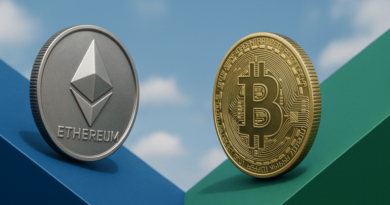High Gas Fees Prevent Ethereum From Being Ethereum

High Ethereum gas prices make it impossible for ERC-20 projects to run any microtransaction payments on Ethereum. This defeats the idea of using the Ethereum network for one of its principal use cases.
Gas fees are part of Ethereum. They are the price required for miners to execute transactions. This fee is not constant, it fluctuates depending on network demand. A transaction can be delayed or outrightly rejected if it does not meet the miners’ threshold.
Michael Garbade is the co-founder and CEO of Education Ecosystem. He is a serial tech entrepreneur who formerly worked at Amazon, General Electric, Rebate Networks, Photobucket and Unicredit Group. CoinDesk’s invest: ethereum economy event starts Oct. 14.
The miners’ threshold depends on network usage and congestion. In a way, miners prefer the network to be congested so they can benefit from charging high gas fees. Currently, the decentralized finance (DeFi) movement, the road to Ethereum 2.0 and soaring ether (ETH) transactions are partly to blame for this unsustainable position.
While miners would love to see gas fees going to the moon, this is not good for Ethereum in the long run. There are organizations that pay their contractors in ether because of cheaper transaction fees. However, under the current conditions, it is economically impossible. In the end, there is no incentive for using the Ethereum network. At worst, it becomes a liability.
A solution must be found, and it could come outside the Ethereum network. There are many possible candidates. In response to the high gas fees, Ethereum co-creator Vitalik Buterin tweeted that “more people should be accepting payments directly through zkSync/loopring/OMG.”
But first, a look at some of the principal factors in Ethereum’s rising gas prices and how they converge, as well as a few solutions.
See also: Luis Cuende – Ethereum Is Manhattan and Everyone Is Moving to the Suburbs
The DeFi movement
DeFi, or decentralized finance, is an umbrella term for financial services using smart contracts to facilitate transactions without relying on intermediaries. Over the past year, the ecosystem has exploded – at this point last year the total value locked in all DeFi applications hovered around $530 million. Today, it stands around $11.3 billion.
The DeFi train, fueled by yield farming, will not show any signs of slowing down. If anything, it will continue to soar with new projects cropping up from every corner. In early September, SushiSwap, a fork from Uniswap, caused a rise in transaction fees even though it was only one week old. This is an exceptional case but it shows that any new DeFi project with the right marketing and economic model can easily spike gas wars.
The DeFi boom is exposing Ethereum’s scalability issues and ability to cope with rising usage. Naturally, this increase leads to network congestion that, in turn, pushes miners to charge higher gas fees to process transactions on the network.
You cannot blame miners for capitalizing on the DeFi boom. It’s human and business nature to spot opportunities and pounce on them.
Serentity?
The Ethereum 2.0 upgrade, originally known as Serenity, is one of the most highly anticipated updates in the protocol’s history. It will see Ethereum switch from Proof-of-Work (PoW) to Proof-of-Stake (PoS).
Ethereum, due to its consensus mechanism, can only handle 15 transactions per second (TPS) compared to VISA’s 1,500 TPS. The migration to PoS will see the network increase its throughput.
The migration to PoS will also see Ethereum miners replaced by validators who stake their ether to maintain the network. This changes the protocol’s economic model. While the incentive structure for the PoS architecture is yet to be worked out, miners are mainly concerned about the present moment. They want to look out for themselves and not so much about the long-term interests of the network.
Sensing that their days are numbered and equipment soon to be rendered obsolete, all the miners can do is maximize their profits. A classic case of making hay while the sun shines.
Bull runs
Ethereum is experiencing a bull market and is up more than 177% against the U.S. dollar in year-to-date performance, TradingView data shows.
Other assets such as chainlink (LINK) have outperformed ether this year, but Ethereum being Ethereum will attract more attention. It is the second-largest digital asset by market capitalization and this makes it a good choice for traders and speculators.
Temporary solution: zkSync
zkSync, built using zkRollup technology by Matter Labs, is a trustless protocol for scalable low-cost payments on Ethereum. Launched in early 2020 on mainnet, its main reason for release was to enhance a widespread adoption of the public blockchains. Six months later, Matter Labs launched a zkSync beta product on the Ethereum mainnet to allow users to send tokens without worrying about high Ethereum gas fees or a network congestion.
At its launch, zkSync could process more than 200 transactions per second, gradually scalable to up to 2,000 transactions per second. The scalability nature of this layer 2 implementation can potentially see zkSync match Visa’s processing speed.
The zkRollup technology by Matter Labs is responsible for this feat. The rollup enables generation of zero knowledge proofs by third-party validators, who do not have any access to the underlying transaction data within the rollup.
The zkSync fees are below $.01 per transaction and are expected to remain low for the foreseeable future. The fees are also payable using the ERC-20 token being transferred. This is good news given that previously, Ethereum’s transaction fees could only be payable using ETH. zkSync transactions are finalized within minutes and confirmed instantly.
How it adds up
The high gas fees are an opportunity for Ethereum competitors to grab a fair share of the market. But the failure to do so shows Ethereum’s dominance or failure by other smart contract platforms to outperform the world’s second-most valuable blockchain.
At some point, the DeFi hype will run out of steam just like the 2017 initial coin offering bubble did. The miner fees will naturally go down, or by the time this happens, Ethereum will be using a PoS mechanism. The high gas fees are a sign of how many people are in crypto for money. Money is being created out of thin air, and miners for their part in facilitating the transfer of wealth, are cashing in through exorbitant gas fees.
At some point, normality will return because those who truly care for Ethereum will make sure that Ethereum becomes Ethereum. But if this fails to happen, then there is a potential for the rise of a new blockchain to rival and leave behind Ethereum. For now, all those platforms touted as potential “Ethereum killers” have failed.
Or maybe in an unlikely fashion, Ethereum will capitulate under the weight of its own growth.
See also: Matthew Finestone – Ethereum-Enhancers Not Ethereum-Killers



